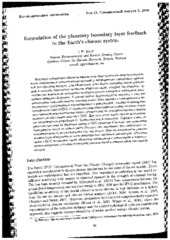Formulation of the planetary boundary layer feedback in the Earth´s climate system
Journal article

Permanent lenke
https://hdl.handle.net/1956/3070Utgivelsesdato
2008Metadata
Vis full innførselSamlinger
Sammendrag
Recent publications have revealed that the state-of-the-art climate models are probably not sensitive enough to observed changes in the surface air temperature. This fact calls for the search of feedback mechanisms making the real climate more sensitive, especially in high latitudes, than the modeled one. A hypothesis, proposed in this study, relates the higher climate sensitivity to physics of the turbulent exchange in the planetary boundary layer (PBL). Assuming certain simplifications, this hypothesis can be developed to obtain analytical relationships for the climate sensitivity due to the PBL-feedback. To obtain those relationships, a new insight from Zilitinkevich et al. studies has been utilized. The analysis paradoxically discovers that stably stratified PBL may respond on the global warming by increase as well as by decrease of the surface air temperature. Another important outcome is a prediction that the mean daily minimum temperature, and especially temperatures in long-lived stably stratified PBL, are more sensitive to the global warming than the mean daily maximum temperature. This fact explains, at least partially, empirically observed asymmetry in the diurnal temperature trends and almost global reduction of the diurnal temperature range.